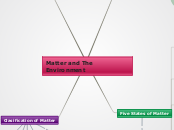Matter and The Environment
Biotic and Abiotic Factors
Biotic Factors
All the living thing or their materials that directly or indirectly affect an organism in its environment.
Examples of Biotic Factors 1. Human 2. Mold 3. Oysters 4. Coral 5. Bacteria 6. Morning Glory
Abiotic Factors
Non-living physical and chemical factors which affect the ability of organisms to survive and reproduce.
Examples of Abiotic Factors 1. Virus 2. Crystals 3. Rocks 4. Volcano 5. Stars
Five States of Matter
Solid
Characterized by: 1. Structural rigidity. With a determined shape. 2. Resistance to changes of shape or volume and difficult to deform (in some cases). 3. They occupy a specific area or volume. 4. Molecules are compressed.
Liquid
Characterized by: 1. They take the shape of the container which contains them. 2. Occupy a specific volume. 3. Molecules are separated.
Gas
Characterized by: 1. No definite shape 2. Expand to occupy the entire available volume. 3. Molecules are all over (very separated).
Plasma
Characterized by: 1. Result of rise in temperature of a gas. 2. Gas made up of particles carrying electric charge. ( ionization of gas at higher temperatures).
Bose-Einstein Condensate
Characterized by: 1. Atoms cannot longer bounce around as individuals. 2. Atoms act in exactly the same way. 3. In 1924, Einstein and Bose, predicted a 5th state of matter which occurs at very low temperatures. 4. Discovered for the first time in 1995 by Wolfgang Ketterle
Matter Properties and changes
Chemical Change
A transformation in which the original substance is converted to one or more new subtances.
Chemical Properties: 1. Reaction with acids 2. Reaction with bases (alkalis) 3. Reaction with oxygen 4. Reaction with... (a lot of more things) 5. Ability to act as axidizing agent 6. Ability to combust 7. Ability to act as a reducing agent 8. Reaction with another elements 9. Decomposition into smaller substances 10. Corrosive
Physical Change
A transformation in a physical property that retains the dentity of the substance.
Physical Properties: 1. Melting Point 2. Vapor Pressure 3. Color 4. State of Matter 5. Density- d= m/v 6. Molecular Mass 7. Electrical and Heat Conductivity 8. Solubility 9. Absorption into a surface 10. Hardness
Clasification of Matter
Matter (Solid, Liquid, Gas, Plasma, Einstein-Bose Condensate)
Pure Substance
Compounds
Elements
Mixture
Homogeneous Mixture
Heterogeneous Mixture
